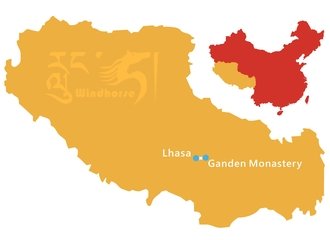Tibetan calendar
The Tibetan Calendar, unlike the Chinese Lunar Calendar or International Solar Calendar, is the unique traditional astronomic calculation method of Tibet. It is a rather accurate science that combines the primitive calendar of Tibet and those of the Indians and the Han people.
For the seclusion and different plateau climate from the inner land, the Tibetans used their own wisdom to explore astronomic changes in their productions and daily life, and finally created a rough series of rules as their guide. Before 100 BC, the indigenous religion of Tibet - Bon marked off months according to the circle of changes of the moon. Later they calculated the recursive date of the Winter Solstice, which was then fixed as the beginning of a year. They also extracted some ideas from the Indian Calendar when Buddhism was introduced from there. In the Tang Dynasty (618 - 907), Princess Wencheng was married to the King of Tibet - Songtsen Gampo - and also brought the imperial calendar (or lunar calendar) of Han people there. The Tibetan Calendar was greatly developed after absorbing these foreign essence. It was finally identified as a formal calendar in the Yuan Dynasty (1271 - 1368) when Tibet was ruled by the Mongol like the inner land, and had been passed on until now.
By the formal Tibetan Calendar, there are 12 months of 354 days a year on average, which was divided into longer months of 30 days and shorter months of 29 days. Passing 1,000 days more or less, another month intervenes to adjust the harmony between months and climate. So the Tibetan New Year and the similar Lunar New Year (Chinese Spring Festival), form a relationship of 'Circle of Three Years' with each other. That is, their dates are the same in the first year, and have a discrepancy of one day the second year and one month the third year. Then they meet again in the fourth year and are circulated like that.
The Tibetan Calendar has a similar way of counting years as the Lunar Calendar by the connection of 10 Heavenly Stems and 12 Earthen Branches to designate marks of order. But the Five Elements (Gold, Wood, Water, Fire, Earth) and 12 Zodiac Attributes (Mouse, Ox, Tiger, Rabbit, Dragon, Snake, Horse, Sheep, Monkey, Chicken, Dog, Pig) are used to replace them and either 'Solar' or 'Lunar' is appended before. For example, we can name a Tibetan year as 'Solar Water Dog'. There is a small circle every 12 years and a big circle 60 years. So 'Solar' and 'Lunar' are often omitted in use without any misunderstanding. The first circle of Tibetan Calendar began in 1027, and the year of 1982 was called as 'Water Dog' in Tibet according to this method.
The Tibetan Calendar also uses 24 solar terms to predict the movement of the Five Planet as well as Solar and Lunar Eclipse. Besides, it can also calculate changes of weather and climate and the earthquake according to the location of the Nine Planets of Solar System, which is out of reach for other calendars. For its research on climate, weather and geography, Tibetan Calendar is also widely advocated in Tibetan Medicine for picking and making herbal medicines, pulse examination and other treatments. Tibetan festivals are also dated on this calendar.














